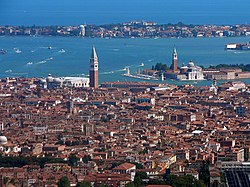|
Metropolitan City of Venice
The Metropolitan City of Venice (Italian: città metropolitana di Venezia) is a metropolitan city in the Veneto region of Italy, one of ten metropolitan cities in Italy. Its capital is the city of Venice. It replaced the province of Venice in 2015[3] and includes the city of Venice and 43 comuni (sg.: comune). It was first created by the reform of local authorities (Law 142/1990) and then established by Law 56/2014. The Metropolitan City of Venice is headed by the Metropolitan Mayor (sindaco metropolitano) and the Metropolitan Council (consiglio metropolitano). Since 15 June 2015, as the new mayor of the capital city, Luigi Brugnaro is the first mayor of the metropolitan city.
HistoryThe area was settled by the 11th century BC. According to legend, Antenor fled from Troy,[4] leading the people of Eneti from Paphlagonia to inhabit the shores of the Adriatic. In 102 BC, The Romans defeated the Cimbri and the Germanic tribes in the area, thus increasing their influence in the region to form the Regio X Venetia et Histria. The exact date when Venice was established is unknown. Still, about 570 refugees from the hinterland, especially from Aquileia, fled to the islands of the Venetian Lagoon to escape the frequent barbaric invasions. At that time, the territory of the province was part of the Byzantine Empire, belonging to the Exarchate of Ravenna.[5] Over the centuries, Venice became more independent and in 697 it had its first Doge. With the destruction of Eracliana in 805, the capital was moved to Rialto (Venice).[6] In the Middle Ages, Venice became an important maritime republic, completely independent from Byzantium, and began its expansion into the hinterland. In 1260, the Ezzelini family was defeated.[7] Threatened by the expansionist ambitions of the Visconti of Milan, in 1365, Venice began to invade neighbouring territories. By 1410, the Regio X Venetia et Histria had annexed Padua and Verona. By the 16th century, the Republic included territories from the Julian Alps to Crema, Istria, Dalmatia, Cyprus and part of the Peloponnese.[8] In 1797, Napoleon invaded the Republic and, following the Treaty of Campo Formio, it was ceded to Austria. After the final defeat of Napoleon, the Austrian Empire founded a province of Venice on the Adriatic Sea.[8] In 2015, this was converted into the current metropolitan city. Geography Facing east on the northern Adriatic Sea,[9] the metropolitan city is bordered to the northeast by the province of Udine and province of Pordenone, south by the province of Rovigo, and to the west by the province of Padua and province of Treviso. The municipalities of Chioggia, Cavarzere and Cona constitute an exclave, separated from the rest of the metropolitan city by the Paduan municipalities of Codevigo and Correzzola, bordering the provinces of Padua and Rovigo. The Brenta and Livenza rivers flow through the metropolitan city. The Piave flows into the Adriatic Sea after passing the town of Eraclea. The 174 kilometres (108 mi) long Brenta runs from Trentino to the Adriatic just south of the Venetian Lagoon.[10] It was first channeled in the 16th century when a long canal was built from the village of Stra to the Adriatic, bypassing Venetian Lagoon. A branch of the Brenta, the Naviglio Brenta, was left to directly connect Venice and Padua.[11] The river runs through Stra, Fiesso d'Artico, Dolo, Mira, Oriago and Malcontenta to Fusina in the northeast. In the area known as the Mandamento of Portogruaro that borders the Friuli Venezia Giulia region, it is estimated that 29% of the population speaks fluent Friulian. The language has been officially recognized and protected as a minority language since 2006.[12] GovernmentList of Metropolitan Mayors of Venice
Metropolitan areaThe spread of the larger Venice metropolitan area has dramatically accelerated over recent decades. The Padua–Treviso–Venice metropolitan area (PATREVE), or Venice City-Region, is an urban agglomeration including the Metropolitan City of Venice as well as the cities of Padua and Treviso and their respective provinces, all in the Veneto region of northeast Italy.[13] It is defined statistically and does not correspond to a single area of local government. Administratively it comprises 240 comuni (sg.: comune), 104 in the province of Padua, 95 in the province of Treviso and 44 in the Metropolitan City of Venice.[14][15] The metropolitan area has a total population of 2,600,000.[16] Main sightsIn addition to the city of Venice, the province offers several other attractions, including Caorle on the Adriatic Coast with its narrow streets, coloured houses, and cylindrical bell tower, and Jesolo, with its long sandy beach, tourist attractions, and nightlife.[17] The second largest municipality in the province, Chioggia, on the southern side of the Venetian Lagoon, includes numerous canals, bridges and mansions as well as St. Felice Castle and the Piazza di Vigo.[18] See alsoReferences
|
||||||||||||||||||||||||||||||||||||||||||||||||||||||||||||||||||||||||||||||||||||||||



